CyberTAN Technology ISB7105W Internet Protocal Set Top Box Basic SD/HD with WiFi User Manual
CyberTAN Technology Inc. Internet Protocal Set Top Box Basic SD/HD with WiFi
User manual

Installation Manual
Cisco IPTV Receivers
Model ISB7105
ISB7105W
3
Contents
Notice for Installers ..........................................................................................................4
IMPORTANT SAFETY INSTRUCTIONS..............................................................................4
Change the Way You Watch TV .......................................................................................7
What’s In the Carton? ......................................................................................................7
Safety First .......................................................................................................................7
Identify Your Receiver with the Serial Number .................................................................7
In This Manual ..................................................................................................................7
Protecting You and the Environment ................................................................................7
Front Panel .......................................................................................................................8
Back Panel .......................................................................................................................9
Connecting the Receiver ................................................................................................10
ISB7105 Wireless Network Connection .........................................................................11
Connecting the Wireless Access Point to the Wireless Gateway ........................................ 12
Pairing the Wireless Access Point and Receiver ............................................................12
Connections for a High-De nition TV (HDTV) ................................................................13
Connections for a Standard-De nition TV (SDTV) .........................................................14
Connections for a VCR or DVD Recorder .......................................................................15
Connecting an Over-the-Air Converter Box ...................................................................15
Connecting to an HDTV with an HDMI Connector ..........................................................16
Connecting to an HDTV with a DVI Connector ...............................................................17
Connecting to an HDTV with Component (YPbPr) Connectors ......................................18
Connecting to an SDTV with Component (YPbPr) Connectors ......................................19
Connecting to an SDTV with an RCA-Type Connector ..................................................20
Connecting to a Home Theater System with Component (YPbPr) Connectors .............21
Connecting to a Stereo VCR or DVD Recorder (optional) ..............................................22
Troubleshooting .............................................................................................................23
Avoid Screen Burn-In .....................................................................................................23
Frequently Asked Questions ..........................................................................................24
Picture Formats ..............................................................................................................25
Index ..............................................................................................................................26
Compliance Information .................................................................................................28
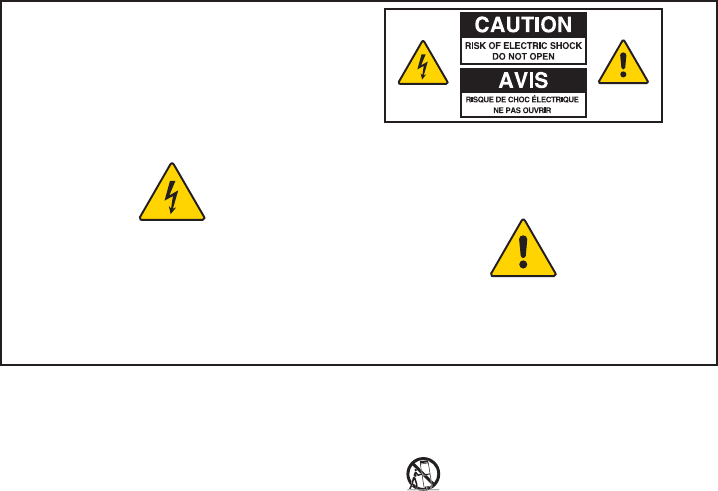
4
1) Read these instructions.
2) Keep these instructions.
3) Heed all warnings.
4) Follow all instructions.
5) Do not use this apparatus near water.
6) Clean only with dry cloth.
7) Do not block any ventilation openings. Install in
accordance with the manufacturer’s
instructions.
8) Do not install near any heat sources such as
radiators, heat registers, stoves, or other
apparatus (including ampli ers) that produce
heat.
9) Do not defeat the safety purpose of the
polarized or grounding-type plug. A polarized
plug has two blades with one wider than the
other. A grounding-type plug has two blades
and a third grounding prong. The wide blade or
the third prong are provided for your safety. If
the provided plug does not t into your outlet,
consult an electrician for replacement of the
obsolete outlet.
10) Protect the power cord from being walked on
or pinched particularly at plugs, convenience
receptacles, and the point where they exit from
the apparatus.
11) Only use attachments/accessories speci ed by
the manufacturer.
12) Use only with the cart, stand, tripod,
bracket, or table specified by the
manufacturer, or sold with the apparatus.
When a cart is used, use caution when moving
the cart/apparatus combination to avoid injury
from tip-over.
13) Unplug this apparatus during lightning storms
or when unused for long periods of time.
14) Refer all servicing to quali ed service personnel.
Servicing is required when the apparatus has
been damaged in any way, such as a power-
supply cord or plug is damaged, liquid has been
spilled or objects have fallen into the apparatus,
the apparatus has been exposed to rain or
moisture, does not operate normally, or has
been dropped.
Power Source Warning
A label on this product indicates the correct power
source for this product. Operate this product only from an
electrical outlet with the voltage and frequency indicated
on the product label. If you are uncertain of the type of
power supply to your home or business, consult your
service provider or your local power company.
The AC inlet on the unit must remain accessible and
operable at all times.
IMPORTANT SAFETY INSTRUCTIONS
Notice for Installers
The servicing instructions in this notice are for use by quali ed service personnel only. To reduce the risk of electric
shock, do not perform any servicing other than that contained in the operating instructions, unless you are quali ed
to do so.
20080814_Installer800
Note to System Installer
WARNING
TO PREVENT FIRE OR ELECTRIC SHOCK, DO NOT
EXPOSE THIS UNIT TO RAIN OR MOISTURE.
For this apparatus, the cable shield/screen shall be grounded
as close as practical to the point of entry of the cable into the
building.For products sold in the US and Canada, this
reminder is provided to call the system installer's attention to
Article 800-93 and Article 800-100 of the NEC (or Canadian
Electrical Code Part 1), which provides guidelines for proper
grounding of the cable shield.
This symbol is intended to alert you that uninsulated voltage
within this product may have sufficient magnitude to cause
electric shock.Therefore, it is dangerous to make any kind of
contact with any inside part of this product.
Ce symbole a pour but d’alerter toute personne qu’un contact
avec une pièce interne de ce produit, sous tension et non isolée,
pourrait être suffisant pour provoquer un choc électrique. Il est
donc dangereux d’être en contact avec toute pièce interne de
ce produit.
This symbol is intended to alert you of the presence of important
operating and maintenance (servicing) instructions in the literature
accompanying this product.
Ce symbole a pour but de vous avertir qu’une documentation
importante sur le fonctionnement et l’entretien accompagne ce produit.
CAUTION: To reduce the risk of electric shock, do not remove cover (or
back). No user-serviceable parts inside. Refer servicing to qualified
service personnel.
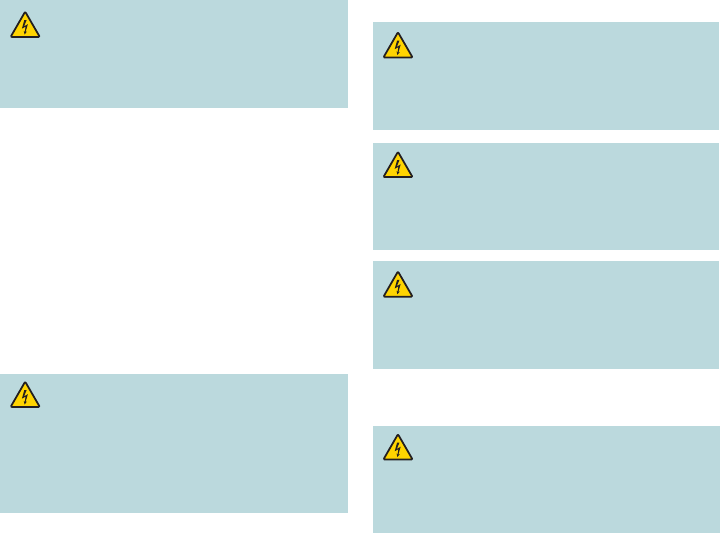
5
Ground the Product
WARNING: Avoid electric shock and fire
hazard! If this product connects to cable wiring,
be sure the cable system is grounded (earthed).
Grounding provides some protection against
voltage surges and built-up static charges.
Protect the Product from Lightning
In addition to disconnecting the AC power from the wall
outlet, disconnect the signal inputs.
Verify the Power Source from the
On/O Power Light
When the on/off power light is not illuminated, the
apparatus may still be connected to the power source.
The light may go out when the apparatus is turned o ,
regardless of whether it is still plugged into an AC power
source.
Eliminate AC Power/Mains Overloads
WARNING: Avoid electric shock and fire
hazard! Do not overload AC power/mains,
outlets, extension cords, or integral convenience
receptacles. For products that require battery
power or other power sources to operate them,
refer to the operating instructions for those
products.
Provide Ventilation and
Select a Location
• Remove all packaging material before applying power
to the product.
• Do not place this apparatus on a bed, sofa, rug, or
similar surface.
• Do not place this apparatus on an unstable surface.
• Do not place this apparatus in excessive heat or
moisture.
• Do not install this apparatus in an enclosure, such as
a bookcase or rack, unless the installation provides
proper ventilation.
• Do not place entertainment devices (such as VCRs
or DVDs), lamps, books, vases with liquids, or other
objects on top of this product.
• Do not block ventilation openings.
Operating Environment
This product is designed for operation indoors with a
temperature range from 32° to 104° F (0° to 40°C).
Each product should have adequate spacing on all
sides so that the cooling air vents on the chassis are
not blocked.
Protect from Exposure to Moisture
and Foreign Objects
WARNING: Avoid electric shock and fire
hazard! Do not expose this product to dripping or
splashing liquids, rain, or moisture. Objects lled
with liquids, such as vases, should not be placed
on this apparatus.
WARNING: Avoid electric shock and fire
hazard! Unplug this product before cleaning. Do
not use a liquid cleaner or an aerosol cleaner. Do
not use a magnetic/static cleaning device (dust
remover) to clean this product.
WARNING: Avoid electric shock and fire
hazard! Never push objects through the openings
in this product. Foreign objects can cause
electrical shorts that can result in electric shock
or re.
Service Warnings
WARNING: Avoid electric shock! Do not open
the cover of this product. Opening or removing
the cover may expose you to dangerous voltages.
If you open the cover, your warranty will be void.
This product contains no user-serviceable parts.
Check Product Safety
Upon completion of any service or repairs to this product,
the service technician must perform safety checks
to determine that this product is in proper operating
condition.
Protect the Product When Moving It
Always disconnect the power source when moving the
apparatus or connecting or disconnecting cables.
20110316_IP_No Tuner_Safety
IMPORTANT SAFETY INSTRUCTIONS, continued
7
Change the Way You Watch TV
Welcome to Internet Protocol TV (IPTV). The ISB7105 devices, known as IPTV receivers,
bring a rich, new set of interactive services directly to you through your TV and your
in-home IP network. The receiver uses wireless technology 802.11n to connect to the
network.
The ISB7105 receiver allows for easy and secure connection to IPTV services. The signal
strength indicator on the front panel of the receiver identi es the strength of the wireless
connection and aids in the proper placement of the receiver.
What’s In the Carton?
In addition to this installation manual, the receiver carton contains the following items:
• An ISB7105 Receiver - A wireless receiver
• A power cord and power adapter
To support the wireless functionality of the ISB7105 receiver, you will also need a
wireless access point that is packaged separately from your receiver. See page 12 of
this guide for more information on the wireless access point.
Safety First
Before using the receiver, read the Important Safety Instructions section of this manual.
Identify Your Receiver with the Serial Number
At times your service provider may ask for the serial number. To nd the serial number
for your receiver, look on the bottom of the receiver for the label. The serial number is a
9-digit numeric code to the right of the letters “S/N” on the label.
Use the space provided here to record the serial number:
_______________________________
In This Manual
This manual covers the information you need to connect your receiver to both your
in-home IP network and your entertainment system. The manual also outlines certain
safeguards and installation information. The safety information contained in this manual
was developed and provided solely by the receiver manufacturer, Cisco Systems, Inc.
Protecting You and the Environment
Cisco addresses the environmental impact of networking products throughout their lifecycle,
from product development, manufacturing, and use to service and end-of-life. Integrating
environmental policies into Cisco engineering and manufacturing practices results in socially
accountable business practices that help reduce the environmental impact associated with
networking products.

8
Front Panel
1 Power Turns the receiver on or places it in standby. To restart the
receiver, press and hold the POWER button for 10 seconds. The
LED is green
2 Model Number Identi es the model number of your receiver as ISB7105
3 Signal Strength Identi es the strength of the wireless connection
Indicator
4 Link Indicates network link status. The LED is green
5 HD Indicates the set-top is set to a resolution of 720p, 1080i, or
1080p. The LED is blue
6 Record Indicates that a recording is in progress. The LED is red
7 IR Sensor Receives the infrared signal from the remote control. The sensor
is behind the front panel
8 Menu Accesses the on-screen menu
9 Arrow Keys Accesses on-screen services (such as the on-screen guide,
video-on-demand, or pay-per-view) and navigates menus
10 OK Selects the current item
11 USB Port USB connector. (Reserved for future use)
Note: This illustration may vary from the actual product.
POWER LINK HD REC
OK
MENU
ISB7105
T15768
1102 3 4 5 6 7 8 119

9
Back Panel
1 Network Connect to the Ethernet (CAT-5) network at your home, if
applicable
2 YPbPr Connect the receiver to the component video input (YPbPr) on
the HDTV. See pages 13 and 14 for more information
3 Video Out Connect to composite input on your HDTV or SDTV
4 Audio Out (L/R) Connect RCA-type cables to Audio Out to send analog audio
signals (left and right) to a TV with stereo inputs or to a stereo
ampli er
5 HDMI Connect an HDTV HDMI™ (High-De nition Multimedia Interface)
cable from the HDTV to the HDMI port. HDMI supports both
digital audio and video. See page 13 for more information
6 Optical Connect an optical cable to send a digital audio signal to a
surround-sound receiver or other digital audio device
7 Power Connect the DC output of the AC power adapter (provided) to
deliver power to the receiver
Note: This illustration may vary from the actual product.
NETWORK
LR
Pr Pb Y VIDEO
OUT AUDIO
OUT OPTICAL POWER
T15769
1 32 4 5 6 7
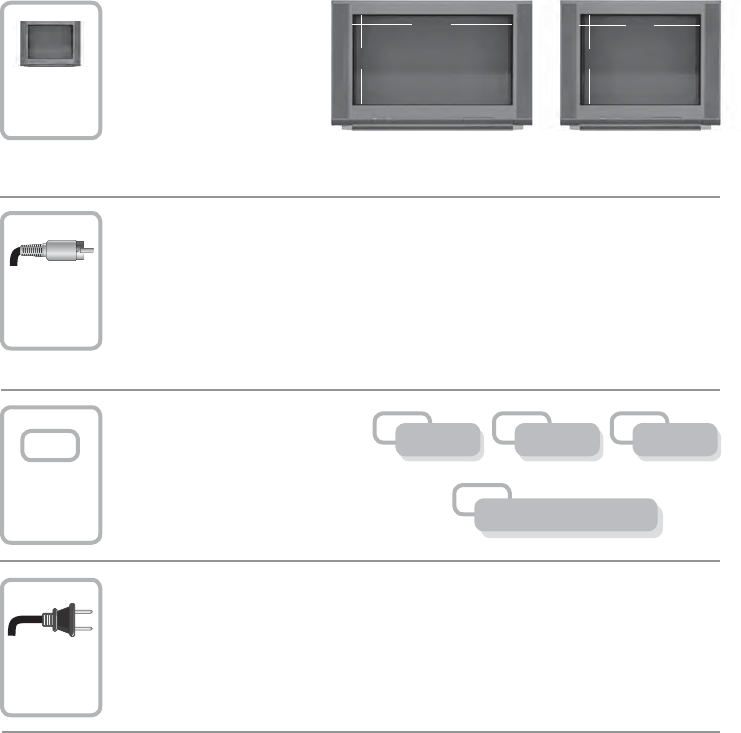
10
Because the connections
for a high-de nition (HD)
or standard-de nition (SD)
TV are di erent, you must
determine if your TV is HD
or SD. Your TV must
receive HD signals for
you to enjoy the bene ts of HDTV. Refer to the manual that came with your TV
for more information. See page 25 for more information on picture formats.
Connecting the Receiver
To connect your receiver to your network and home entertainment devices, complete
these steps.
Identify the additional
consumer electronic devices
you will connect to the
receiver and TV. See pages
16 through 22 and refer to
the owner’s manual for the
device.
Plug the receiver and the TV into an AC power source that is not
controlled by a switch. For further instructions on completing your setup,
contact your service provider.
Make the connections for your TV, VCR, and DVD recorder as follows:
• If you are using an HDTV, see page 13 and the connection diagrams in
this manual.
• If you are using a standard-de nition TV, see page 14 and the
connection diagrams in this manual.
• If you want to record some programs on VCR tape or DVD, see page 15
and the connection diagrams in this manual.
1
2
4
3
Home Theater
Other
DVDVCR
9
16 4
3
or
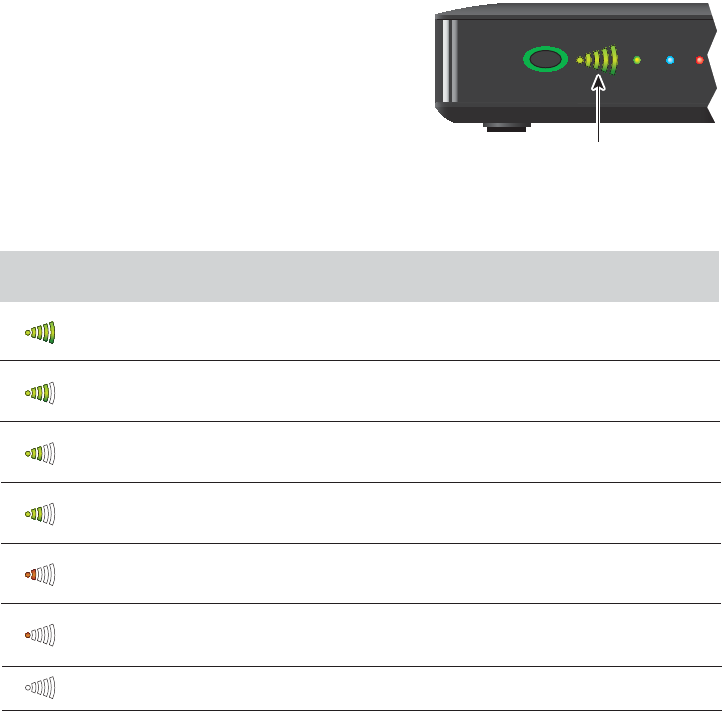
11
ISB7105 Wireless Network
Connection
The ISB7105 receiver allows for easy and secure
connection to IPTV services. The signal strength
indicator on the front panel of the receiver identi es
the strength of the wireless connection and aids in
the proper placement of the receiver.
• The receiver must be paired with the wireless access point for the wireless
connection to be established. See page 12 for more information.
Wireless
LEDs Receiver Operational Status
This indicates the wireless signal is excellent. The video quality is good.
This indicates the wireless signal is very good. The video quality is good.
This indicates the wireless signal is good. The video quality is good.
You must obtain three or more green bars at initial installation.
This indicates the wireless signal is fair. The video quality is good.
This indicates the wireless signal is weak. The video quality may be poor.
The STB should be re-oriented to achieve a better wireless signal.
This indicates the wireless signal is very weak. No video can be displayed.
The receiver must be re-oriented to achieve a better wireless signal.
This indicates no wireless connectivity.
POWER LINK HD REC
ISB7105
Signal Strength Indicator
T15770
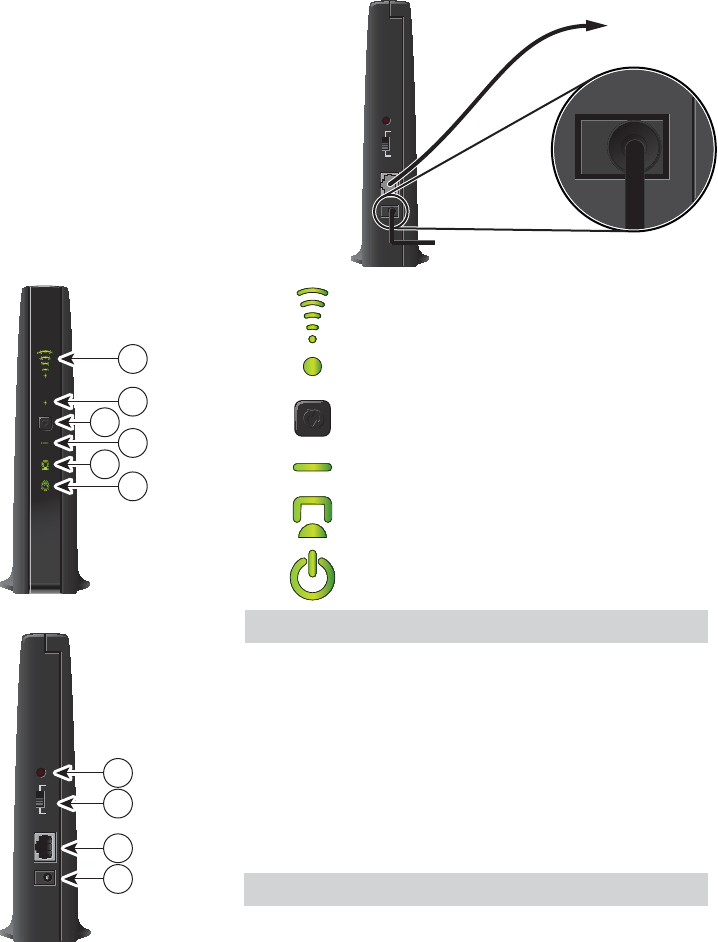
12
Connecting the Wireless Access Point to the Wireless
Gateway
1.Connect the 12 VDC Power Supply plug
on the access point to the wall power
outlet. Use only the power adapter
provided with the product.
2. Connect the power plug to the power
receptacle on the wireless access point.
3. Connect one end of the RJ-45 Ethernet
cable to the Ethernet port on the
wireless access point.
4. Connect the other end of the RJ-45
Ethernet cable to an available Ethernet port
on your wireless gateway.
1 Wireless LED
2 Wireless Link LED
3 Wi-Fi Protected Setup™ (WPS) button
4 Wi-Fi Protected Setup (WPS) LED
5 Ethernet LED
6 Power LED
Note: This illustration may vary from the actual product.
1 Reset Restores factory default settings when
held for more than 5 seconds
2 Mode Switch Converts the wireless access point to
a wireless client
3 Ethernet Port Connects the wireless access point to
a receiver or wireless gateway
4 Power Connects device to the external
12 VDC power supply
Note: This illustration may vary from the actual product.
Pairing the Wireless Access Point and Receiver
1. Press the OK button on the receiver.
2. Press the WPS button on the wireless access point.
T15773
Power
Receptacle
RJ-45
Cable
Reset
Ethernet
12VDC
CL
AP
12VDC
To Wall
Power Outlet
Wireless
Gateway
Ethernet Port
T15771
1
2
3
4
5
6
Reset
Ethernet
12VDC
CL
AP
T15772
1
2
3
4
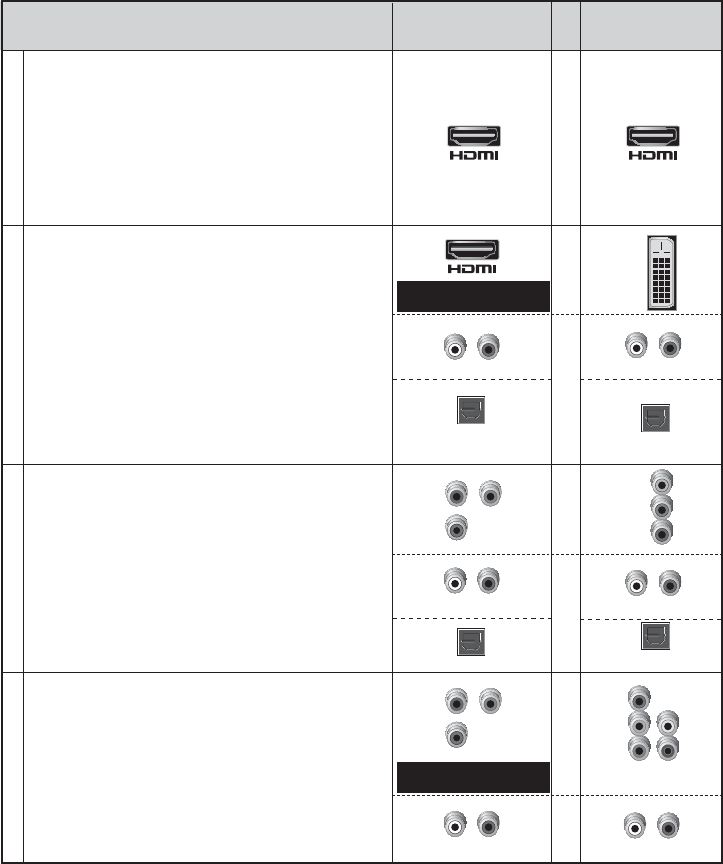
13
Connections for a High-De nition TV (HDTV)
To use the receiver with an HDTV, you must make one of the following connections to
view the HD content. Refer to the owner’s manual for your TV and the cabling diagrams
in this manual for more detailed connection information.
Although all connections provide you with quality service, we list the connections in our
recommended order.
Notes:
• The labeling on your receiver or HDTV may vary slightly from the illustrations shown below.
• Some cables shown in the connection diagrams may not be included with this receiver.
Some HDTVs have a High-De nition
Multimedia Interface (HDMI) connector. The
HDMI connector provides both a digital video
and audio connection. See the connection
diagram on page 16 for an example.
Note: The HDMI port on the TV must
support high-bandwidth digital content
protection (HDCP).
HDTV
Connections
The HDMI connector can provide the
connection to an HDTV with a DVI input. If
your HDTV has a Digital Visual Interface
(DVI) connector, you need an HDMI-to-DVI
adapter, and a separate audio connection
(either L/R or optical audio).
Note: The DVI port on the TV must support
high-bandwidth digital content protection
(HDCP).
See the connection diagram on page 17
for an example.
Use One of These Required
Connections to an HDTV
DVI
Receiver
Connections
The YPbPr (red, blue, and green)
connectors provide high-de nition
component video signals to an HDTV, and
a separate audio connection (either L/R or
optical audio).
See the connection diagram on page 18 for
an example.
Pr
Pb
Y
Audio/VideoVideoVideo
DVI HDMIYPbPr
Pr
Pb Y
Some HDTVs have only RGB or RGB-
HV connectors. If you have one of these
HDTVs, you need a Component-to-RGB
adapter, and you need a separate audio
connection.
B
G
V
H
R
Pr
Pb Y
Adapter Needed
Adapter Needed
Video
RGB
Audio
AUDIO
OUT
LR
AUDIO
OUT
LR
OPTICAL
OPTICAL
INPUT
LR
Audio
AUDIO
OUT
LR
OPTICAL
OPTICAL
INPUT
LR
Audio
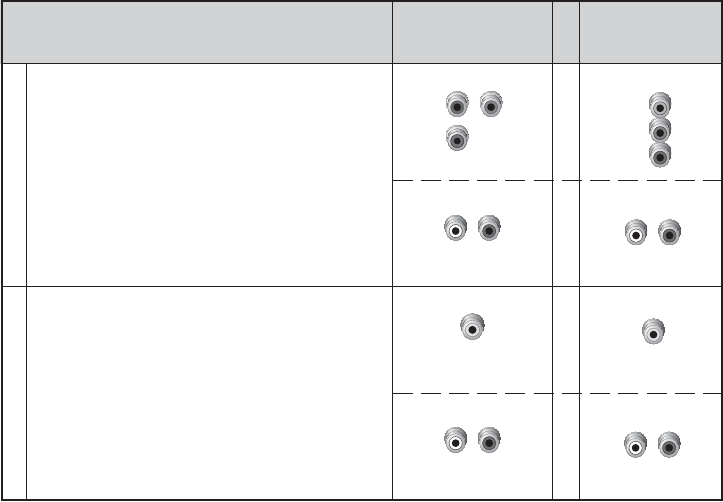
14
Connections for a Standard-De nition TV (SDTV)
When using the receiver with an SDTV, you must make one of the following connections
to view content. Some SDTVs may not have all these connections. Refer to the
owner’s manual for your TV and the cabling diagrams in this manual for more detailed
information.
Although all connections provide you with quality service, we list the connections in our
recommended order.
Notes:
• The labeling on your receiver or SDTV may vary slightly from the illustrations shown
below.
• Some cables shown in the connection diagrams may not be included with this receiver.
The YPbPr (red, blue, and green)
connectors can provide standard-de nition
component video signals to an SDTV. A
separate audio connection is also needed.
See the connection diagram on page 19
for an example.
SDTV
Connections
Use One of These Required
Connections to an SDTV Receiver
Connections
The Video Out connector provides a video
connection to an SDTV. A separate audio
connection is also needed.
See the connection diagram on page 20
for an example.
Video Out
VIDEO
OUT
VIDEO
IN
LR
Pr
Pb
Y
LR
YPbPr
Audio VideoAudio Video
Pr
Pb Y
AUDIO
OUT
LR
AUDIO
OUT
LR
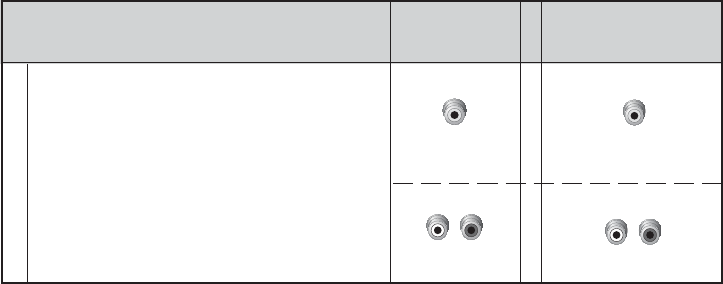
15
Connections for a VCR or DVD Recorder
When using the receiver with a VCR or DVD recorder, you must make one of the
following connections to view content.
Although all connections provide you with quality service, we list the connections in our
recommended order.
Notes:
• The labeling on your receiver, VCR, or DVD recorder may vary slightly from the
illustrations shown below.
• Some cables shown in the connection diagrams may not be included with this receiver.
Connecting an Over-the-Air Converter Box
You can connect an over-the-air converter box directly to your TV to receive certain
local channels, but do not connect the over-the-air converter box directly to your
receiver.
For VCRs or DVD recorders with Video
In and Left and Right audio connectors,
use the Video Out and the Audio Out
connectors (Left and Right) on the
receiver.
See the connection diagram on page 24
for an example.
VCR/DVD Recorder
Connections
Use One of These Optional Connections
to a VCR or DVD Recorder Receiver
Connections
VCR/DVD Recorder
Audio Video
VIDEO
OUT
VIDEO
IN
LR
AUDIO
OUT
LR
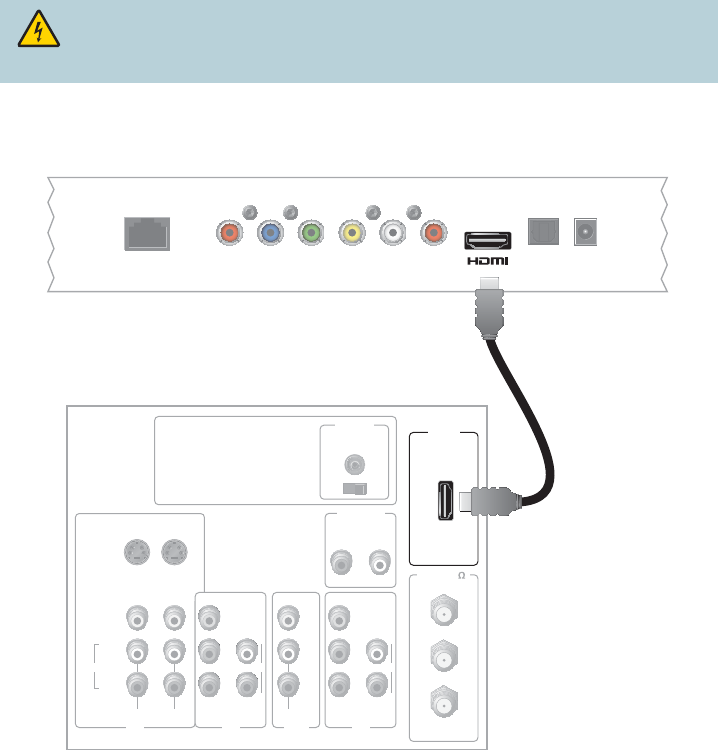
16
Connecting to an HDTV with an HDMI Connector
Cable Used in this Con guration
• 1 HDMI Cable
Notes:
• The HDMI port on the TV must support high-bandwidth digital content protection (HDCP).
• The HDMI interface supports Dolby™ Digital 5.1 audio.
WARNING: Electric shock hazard! Unplug all electronic devices before
connecting or disconnecting any device cables to the receiver.
Receiver
T15774
Back of HDTV
HDMI
AUDIO
CENTER
CHANNEL IN
AUDIO IN
DVI/HDCP
ANT (75 )
INOUT
LR
ANT-1
HD 2
Y
OUT
ANT-2
PB
PR
L
R
VIDEO
L/
MONO
R
L/
MONO
R
AUDIO
IN
ON OFF
IN
HD 1
S-VIDEO
VIDEO Y
PB
PR
L
R
AUDIOAUDIO
NETWORK
LR
Pr Pb Y VIDEO
OUT AUDIO
OUT OPTICAL POWER
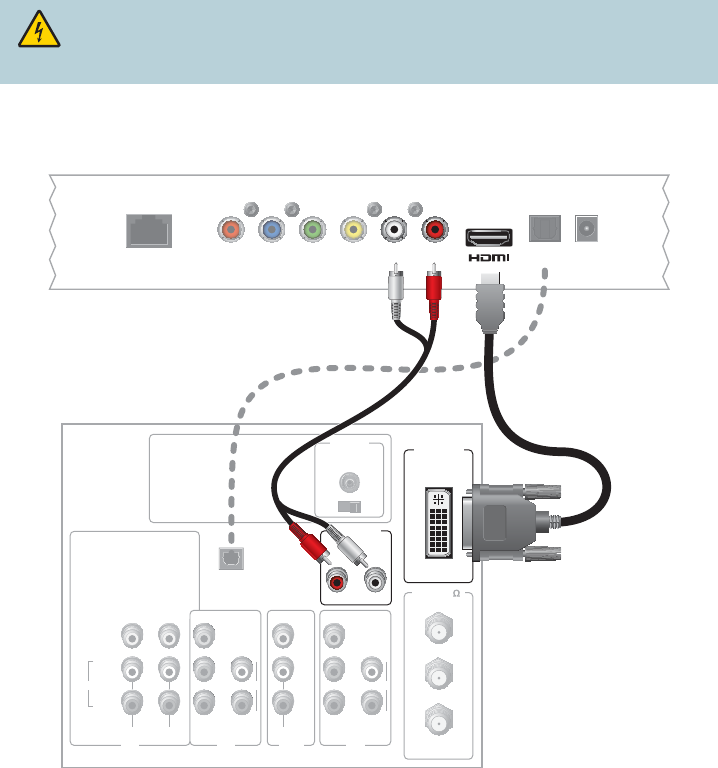
17
Connecting to an HDTV with a DVI Connector
Cables Used in this Con guration
• 1 HDMI-to-DVI Cable or 1 HDMI Cable and 1 HDMI-to-DVI Adapter
• 1 Audio Left/Right Cable (You can also use an optical cable [indicated by the dotted
line] instead of the Audio Left/Right Cable as shown in the diagram, dependent upon
your TV’s capabilities.)
Notes:
• The DVI port on the TV must support high-bandwidth digital content protection (HDCP).
• When you connect the HDMI connector to the DVI connector on your HDTV, you need
an HDMI-to-DVI adapter and a separate audio connection.
WARNING: Electric shock hazard! Unplug all electronic devices before
connecting or disconnecting any device cables to the receiver.
Receiver
NETWORK
LR
Pr Pb Y VIDEO
OUT AUDIO
OUT OPTICAL POWER
Back of HDTV
AUDIO
CENTER
CHANNEL IN
ANT (75 )
INOUT
ANT-1
HD 2
Y
OUT
ANT-2
PB
PR
L
R
VIDEO
L/
MONO
R
L/
MONO
R
AUDIO
IN
ON OFF
IN
HD 1
S-VIDEO
VIDEO Y
PB
PR
L
R
AUDIOAUDIO
DVI/HDCP
IN
AUDIO IN
DVI/HDCP
LR
OPTICAL
INPUT
OR
T15775
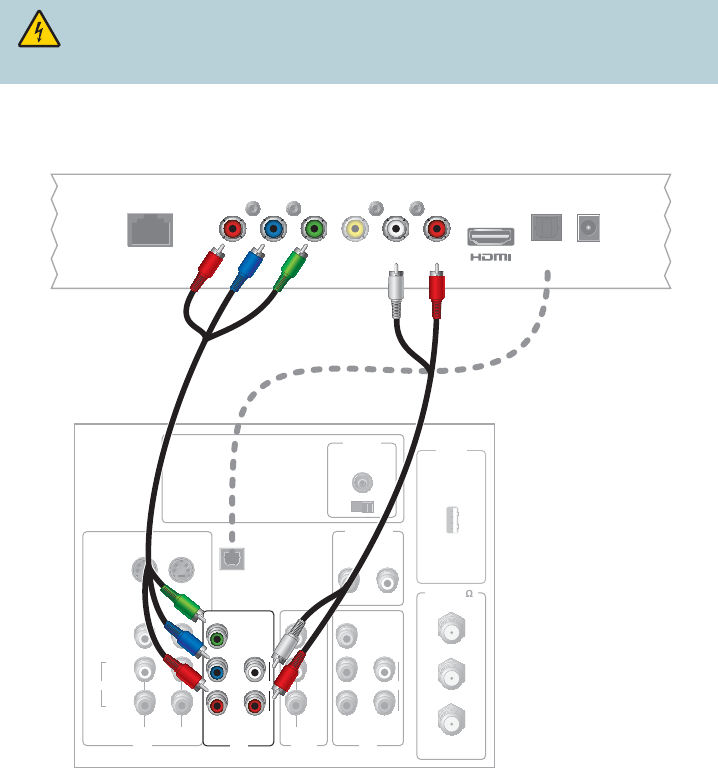
18
Connecting to an HDTV with Component (YPbPr)
Connectors
Cables Used in this Con guration
• 1 Component Video Cable (YPbPr)
• 1 Audio Left/Right Cable (You can also use an optical cable [indicated by the dotted line]
instead of the Audio Left/Right Cable as shown in the diagram, dependent upon your
TV’s capabilities.)
WARNING: Electric shock hazard! Unplug all electronic devices before
connecting or disconnecting any device cables to the receiver.
Receiver
T15776
NETWORK
LR
Pr Pb Y VIDEO
OUT AUDIO
OUT OPTICAL POWER
Back of
HDTV
HDMI
AUDIO
CENTER
CHANNEL IN
AUDIO IN
DVI/HDCP
ANT (75 )
INOUT
LR
ANT-1
HD 2
Y
OUT
ANT-2
PB
PR
L
R
VIDEO
L/
MONO
R
L/
MONO
R
AUDIO
IN
ON OFF
S-VIDEO
VIDEO
AUDIO
IN
HD 1
Y
PB
PR
L
R
AUDIO
OPTICAL
INPUT
OR
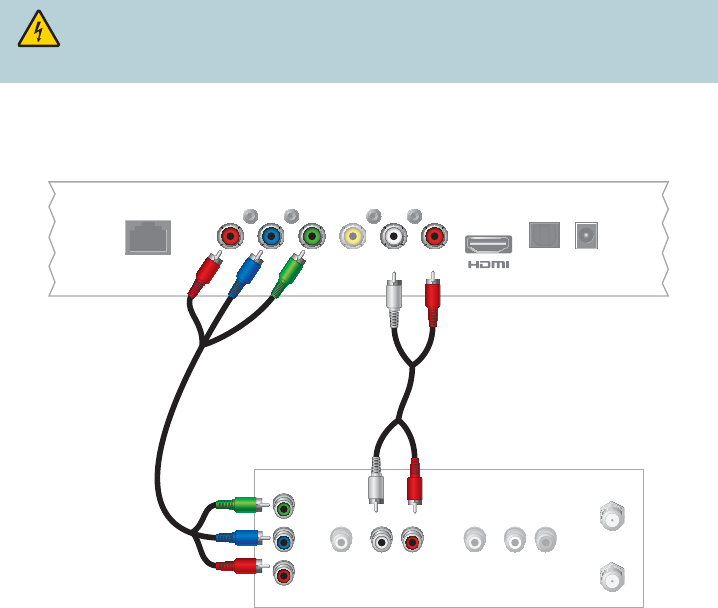
19
Connecting to an SDTV with Component (YPbPr)
Connectors
Cables Used in this Con guration
• 1 Component Video Cable (YPbPr)
• 1 Audio Left/Right Cable
Note: The receiver must be set to the proper standard-de nition mode.
WARNING: Electric shock hazard! Unplug all electronic devices before
connecting or disconnecting any device cables to the receiver.
Receiver
NETWORK
LR
Pr Pb Y VIDEO
OUT AUDIO
OUT OPTICAL POWER
Back of SDTV
CABLE OUT/
ANT OUT
CABLE IN/
ANT IN
RL
AUDIO
IN
VIDEO
IN
RL
AUDIO
OUT
VIDEO
OUT
Y
PB
PR
T15777
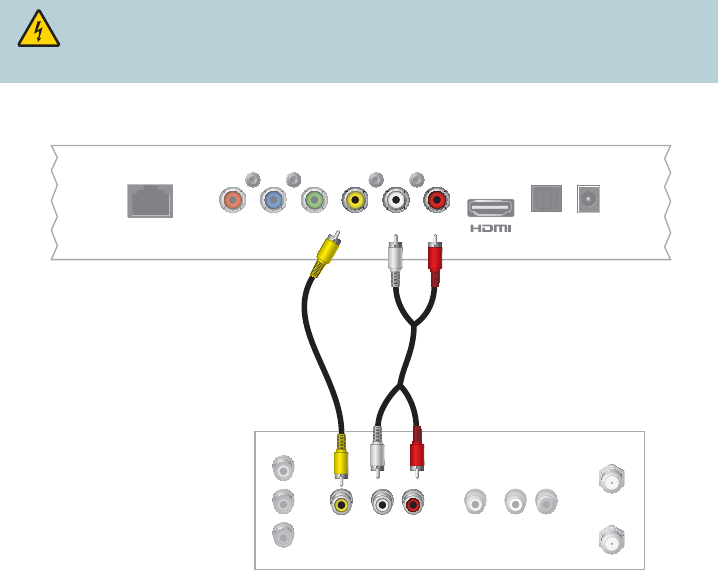
20
Connecting to an SDTV with an RCA-Type Connector
Cables Used in this Con guration
• 1 RCA-type Video Cable
• 1 Audio Left/Right Cable
WARNING: Electric shock hazard! Unplug all electronic devices before
connecting or disconnecting any device cables to the receiver.
Receiver
T15778
NETWORK
LR
Pr Pb Y VIDEO
OUT AUDIO
OUT OPTICAL POWER
CABLE OUT/
ANT OUT
RL
AUDIO
IN
VIDEO
IN
RL
AUDIO
OUT
VIDEO
OUT
Y
PB
PR
CABLE IN/
ANT IN
Back of
SDTV
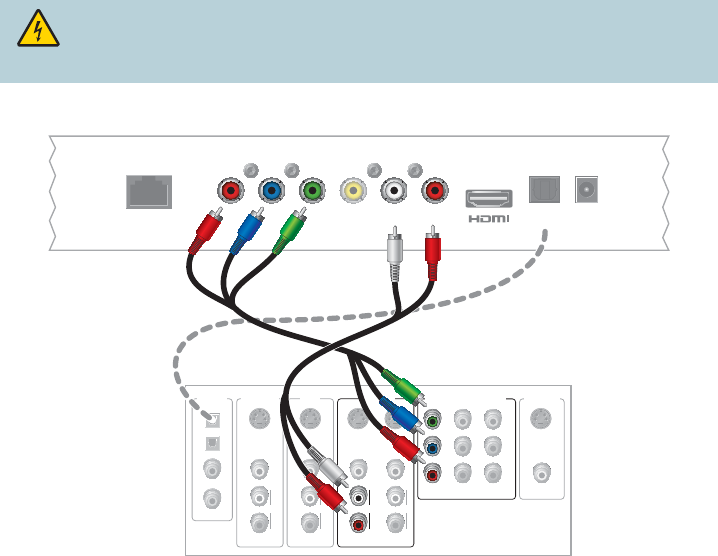
21
Connecting to a Home Theater System
with Component (YPbPr) Connectors
Cables Used in this Con guration
• 1 Component Video Cable (YPbPr)
• 1 Audio Left/Right Cable (You can also use an optical cable [indicated by the dotted
line] instead of the Audio Left/Right Cable as shown in the diagram.)
Notes:
• This connection requires that audio is provided by the home theater system.
• Consult the user guide that came with your home theater system for information on
connecting your other video and audio devices.
WARNING: Electric shock hazard! Unplug all electronic devices before
connecting or disconnecting any device cables to the receiver.
T15779
Receiver
NETWORK
LR
Pr Pb Y VIDEO
OUT AUDIO
OUT OPTICAL POWER
Back of Home
Theater Receiver
COMPONENT VIDEO
1
Y
PB
PR
2
Y
PB
PR
Y
PB
PR
S-VIDEO
DIGITAL
AUDIO TV/CABLE
1
2
3
4
VIDEO
L
R
AUDIO
S-VIDEO
DVD
VIDEO
L
R
AUDIO
VIDEO
L
R
AUDIO
S-VIDEO
VIDEO 1
S-VIDEO
OUT
VIDEO OUT
MONITOR
VIDEO
L
R
AUDIO
S-VIDEO
OUTIN
OUTIN
OR
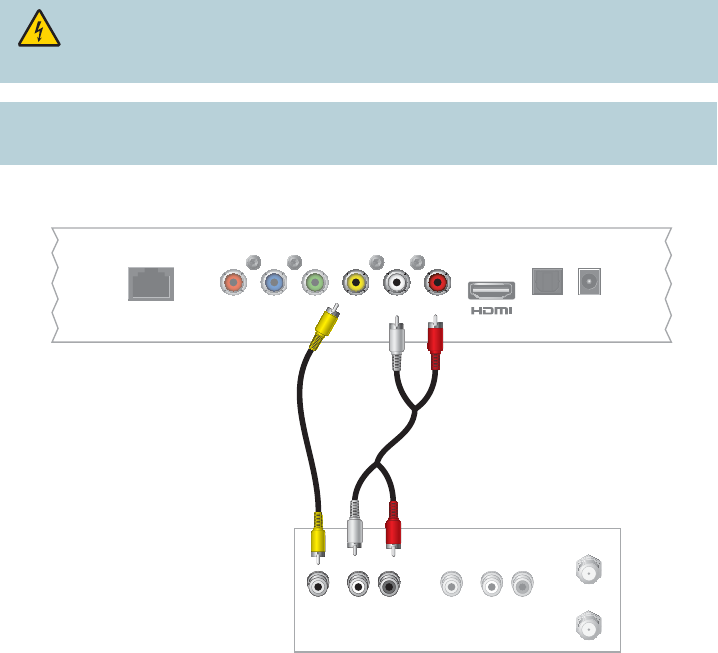
22
Connecting to a Stereo VCR or DVD Recorder (optional)
The diagram below shows how to connect a recording device to your receiver. Although
it is possible to watch TV using a connection through your VCR or DVD recorder to the
TV, this connection may not provide the best picture, and HDTV users are restricted to an
SD format. In addition, some content is copy protected and passing this content through
the recording device may result in a picture that cannot be viewed.
For these reasons, the connection shown is best used to provide only video and audio to
your recording device and not for normal TV viewing. The connection from the recording
device to the TV (only used for playback of recorded material) depends on the type of
device being used, the outputs that are supported, and the inputs that remain available
for use on your TV.
Consult the owner’s manuals provided with your TV and recording device for more
details on connection options.
Cables Used in this Con guration
• 1 RCA-type Video Cable
• 1 Set Audio Left/Right Cables
Connecting your TV directly to the Audio/Video output of your receiver will
assure a more vivid picture and enhance your viewing enjoyment.
WARNING: Electric shock hazard! Unplug all electronic devices before
connecting or disconnecting any device cables to the receiver.
T15780
Receiver
NETWORK
LR
Pr Pb Y VIDEO
OUT AUDIO
OUT OPTICAL POWER
Back of Stereo VCR
or DVD Recorder
CABLE OUT/
ANT OUT
RL
AUDIO
IN
VIDEO
IN
R
L
AUDIO
OU
T
V
IDEO
OU
T
CABLE IN/
ANT IN

23
Troubleshooting
If the receiver does not perform as expected, the following tips may help. If you need
further assistance, contact your service provider.
No Picture
• Verify that the power to your TV is turned on.
• Verify that your wireless receiver and wireless access point are powered on.
• Verify that all cables are properly connected.
• If your system includes a VCR, DVD recorder, or stereo, verify that you have properly
connected the device to the receiver.
• Verify that you are using the proper input selection to the home theater receiver or TV.
• Verify that the receiver is set to the proper screen type and resolution.
• If you are using coaxial cable to connect to your TV, verify that the TV is tuned to the
channel designated by your service provider (usually channel 3). Contact your service
provider for the channel information.
Wireless Receiver Signal Strength
• Verify that you are able to receive wireless signal. See page 11 for details.
• Optimal operating conditions for wireless receivers can vary. Performance depends
on many factors, including distance from the access point, building materials,
interference, and other environmental conditions.
No Color or Incorrect Color
• Verify that the current TV program is broadcast in color.
• Adjust the TV color controls.
• If you are using a component video connection (YPbPr), check that all connectors are
completely and properly plugged into the receiver and TV.
• If you are using a component video connection (YPbPr) and your HDTV has only RGB or
RGB-HV connectors, you must use an adapter. You can obtain the adapter through an
electronic parts retailer.
No Sound
• If your setup includes a VCR, DVD recorder, or stereo, verify that you have properly
connected the device to the receiver.
• Verify that the volume is turned up.
• Verify that the mute function is not on.
• Verify the proper input selection to the home theater receiver or TV.
• If you are using coaxial cable to connect to your TV, verify that the TV is tuned to the
correct channel.
Avoid Screen Burn-In
Images such as letterbox bars or side bars, bright closed-captioning backgrounds, station
logos, or any other stationary images may cause the display in your HDTV to age
unevenly; this is known as screen burn-in. Refer to the owner’s manual that came with
your HDTV for more information.
CAUTION: Avoid screen burn-in. Do not display the same xed images on
your HDTV screen for extended periods of time.
24
Frequently Asked Questions
What Is Digital Television?
Digital television (DTV) is a huge leap forward in television technology compared to analog
television that has been widely available since the 1940s. DTV is delivered and displayed
using digital encoding, similar to the way a PC operates. By using digital technology, there
is no variation in picture and sound quality from the origination point until it is displayed on
your television. You always receive a high-quality picture without the wavy lines or static
you might sometimes get from a weak analog signal. Another feature of digital television
is digital surround sound using Dolby Digital technology, which is the same technology
used to produce the sound you hear in movie theaters.
What Is Standard-De nition Television?
Standard-de nition television (SDTV) is basic digital television programming delivered by your
service provider. Typically, the SDTV screen is the same, nearly square shape as an analog
television screen. Digital images on an SDTV set are crisp and clear—noticeably better than on
a standard analog television set using an antenna to receive over-the-air signals.
What Is High-De nition Television?
High-de nition television (HDTV) is a completely new way to send and receive television
broadcast signals. HDTV images are made up of pixels that are much smaller and closer
together than those used in standard analog television, and there are millions of them. Thus,
HDTV can display ve to six times the detail of analog television to deliver picture quality that is
much more realistic, dimensional, and precise. SDTV programs can be viewed on an HDTV.
Are Local TV Stations or Other Programmers Broadcasting in
HDTV?
Many local TV stations and programmers are transmitting digital signals. However, transmitting
a digital signal does not mean transmitting an HDTV signal. Some stations are using the new
bandwidth to broadcast several standard-de nition channels. Most stations and programmers,
once they begin broadcasting in digital, are o ering HD content from their parent network (for
example, CBS, ABC, NBC, Fox, and PBS). Contact your service provider for more information.
Why Aren’t All the Shows I Watch in High-De nition?
A high-de nition program must originate in HD format and be broadcast in HD format.
Having an HDTV system does not mean that everything you watch will be viewed in high-
de nition. Getting the signal from a digital source also does not mean it is high-de nition.
Why Are Some HDTVs 4:3 Aspect Ratio and Others 16:9?
The aspect ratios di er because television manufacturers build both standard-screen and
wide-screen HDTVs to appeal to consumer viewing preferences. The two aspect ratios
are as follows:
• On standard-screen (4:3) HDTVs, the programming is displayed in letterbox format in
the middle of the screen. There are bars surrounding the picture.
• On wide-screen (16:9) HDTVs, the programming is displayed on the full screen.
What Is HDMI and Does it Support Dolby Digital 5.1 Audio?
The High-De nition Multimedia Interface (HDMI) is an uncompressed, all-digital audio/video
interface. The Dolby Digital audio format that provides up to 5.1 separate channels of surround
sound, and is the standard used for DVD-Video. HDMI supports standard, enhanced, or high-
de nition video, plus multi-channel digital audio, such as Dolby Digital audio, on a single cable.
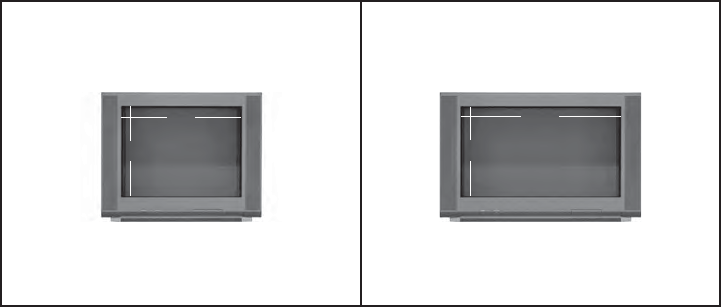
25
Picture Formats
What Is the Di erence Between a Standard-Screen and a
Wide-Screen HDTV?
The type of screen your HDTV has (wide-screen or standard-screen) determines how
the receiver displays programs on the screen. The picture format for an HDTV is a
combination of aspect ratio and screen resolution and is di erent for standard-screen
and wide-screen HDTVs.
What Is Aspect Ratio?
An aspect ratio is the ratio of the width to the height of the TV screen. The aspect ratios
di er because the television industry manufactures both standard-screen and wide-
screen HDTVs to appeal to consumer viewing preferences.
What Is the Screen Resolution?
The screen resolution indicates the amount of detail that the picture displays. Resolution
is identi ed by the number of display lines on the screen. The techniques that an HDTV
uses to “paint” the picture on the screen are referred to as progressive and interlaced.
With the progressive scanning method, the lines are drawn on the screen one at a time
in sequential order. Progressive scanning results in a more detailed image on the screen
and is also less susceptible to the icker commonly associated with interlaced scanning.
The interlaced method involves refreshing pixels in alternation — rst the odd lines and
then the even lines.
For advanced setup, select the screen resolution that your TV can support. Refer to your
Feature Guide and HDTV owner’s manuals to choose the proper screen resolution (480i,
720p, 1080i, or 1080p) for your setup.
For example, a screen resolution of 1080i indicates that the screen shows 1080 lines
in an interlaced display, and 720p indicates that the screens shows 720 lines in a
progressive display.
A standard-screen HDTV has a 4x3
aspect ratio. The screen is 4 units wide
for every 3 units tall.
A wide-screen HDTV is one-third wider
than a standard-screen HDTV. The screen
is 16 units wide for every 9 units tall.
A screen resolution of 480i lls the
screen. A screen resolution of 720p, 1080i, or
1080p lls the screen.
9
16
4
3
26
A
AC Power input 9
Arrow keys 8
Aspect ratio 24
Audio Out 9, 13, 14, 15
B
Back panel 9
Burn-in of screen 23
Buttons See Front Panel
C
Cables 9, 12-23
CAT-5 See Ethernet
Coaxial Cable Input 23
Compliance, FCC 28
Component video connection. See YPbPr
Connectors
See also Front panel; Back panel
DVD recorder 15
required for HDTV 13
VCR 15
Connecting the receiver to other devices
DVD recorder 10, 15, 22
HDTV with Component input
(YPbPr) 18
HDTV with DVI connector 13, 17
HDTV with HDMI connector 13, 16
Home Theater System with Component
input (YPbPr) 23
VCR 9, 10, 15, 22
Connection
Consumer electronic devices 10
Controls See Front panel
D
DC Power output 9
Diagrams. See Connecting the receiver
to other devices
Digital Video Recorder. See DVR
Digital TV, What is it 24
DVD Connection 9, 10, 15, 22
DVI connector 13, 17
E
Ethernet 9, 12
F
FAQs 24
FCC compliance 28
Formats, picture 25
Frequently Asked Questions. See FAQs
Front panel 8
H
HD
format 24
HDTV broadcasting 24
HDTV, what is it 24
indicator 8
HDMI 9, 13, 16
High-de nition See HD
Home theater system connection 21
I
Interlaced screen resolution 25
IR sensor 8
Index
27
Index, continued
K
Keys. See Front panel
N
Network 9, 10, 11
O
Optical Audio Output 9, 13, 17, 18, 21
Over-the-air converter box 15
P
Picture formats 25
Ports. See Connectors
Power 8, 9
Programs, view 24
Progressive screen resolution 25
R
RGB connector 13, 23
S
Safety 4, 5
Scan rates. See screen resolution
Screen
burn-in 23
resolution 25
size 25
Serial number, locating 7
Sound, performance 23
Standard-de nition TV 10, 14, 19, 20, 24
Standard-screen TV 25
T
To TV (Video Out) connector 9, 14, 20
Troubleshooting 23
TV
digital, what is it 24
formats 25
HDTV, what is it 24
programming 24
resolution 25
screen size. See aspect ratio
standard-screen 25
standard-de nition 10, 14, 19, 20, 24
wide-screen 25
U
USB port 8
V
VCR connection 9, 15, 22
Video Out. See To TV
View programs 24
W
Wide-screen TV 25
Y
YPbPr
connector 9, 13, 14, 18, 19, 21
HDTV connection 13, 16-18
home theater connection 21

28
United States FCC Compliance
This device has been tested and found to comply with
the limits for a Class B digital device, pursuant to part 15
of the FCC Rules. These limits are designed to provide
reasonable protection against such interference in
a residential installation. This equipment generates,
uses, and can radiate radio frequency energy. If not
installed and used in accordance with the
instructions, it may cause harmful interference
to radio communications. However, there is no
guarantee that interference will not occur in a
particular installation. If this equipment does cause
harmful interference to radio or television reception,
which can be determined by turning the equipment
OFF and ON, the user is encouraged to try to
correct the interference by one or more of the
following measures:
• Increase the separation between the equipment
and receiver.
• Connect the equipment into an outlet on a circuit
di erent from that to which the receiver is connected.
• Consult the service provider or an experienced
radio/television technician for help.
Any changes or modifications not expressly
approved by Cisco Systems, Inc., could void the
user’s authority to operate the equipment.
The information shown in the FCC Declaration
of Conformity paragraph below is a requirement
of the FCC and is intended to supply you with
information regarding the FCC approval of this
device. The phone numbers listed are for FCC-
related questions only and not intended for
questions regarding the connection or operation
for this device. Please contact your service provider
for any questions you may have regarding the
operation or installation of this device.
FCC Declaration of Conformity
This device complies with Part 15 of FCC Rules.
Operation is subject to the following two conditions:
1) the device may not cause harmful interference,
and 2) the device must accept any interference
received, including interference that may cause
undesired operation.
ISB7105 Receiver
Model ISB7105
Manufactured by: Cisco Systems, Inc.
5030 Sugarloaf Parkway
Lawrenceville, Georgia 30044 USA
Telephone: 678 277-1120
Compliance Information Canada EMI Regulation
This Class B digital apparatus complies with
Canadian ICES-003.
Cet appareil numérique de la class B est conforme
à la norme NMB-003 du Canada.
20081121 FCC Standard
AVC VIDEO LICENSE
With respect to each AVC/H.264 product, we are
obligated to provide the following notice:
THIS PRODUCT IS LICENSED UNDER THE
AVC PATENT PORTFOLIO LICENSE FOR THE
PERSONAL USE OF A CONSUMER OR OTHER
USES IN WHICH IT DOES NOT RECEIVE
REMUNERATION TO (i) ENCODE VIDEO IN
COMPLIANCE WITH THE AVC STANDARD (“AVC
VIDEO”) AND/OR (ii) DECODE AVC VIDEO THAT
WAS ENCODED BY A CONSUMER ENGAGED IN
A PERSONAL ACTIVITY AND/OR WAS OBTAINED
FROM A VIDEO PROVIDER LICENSED TO PROVIDE
AVC VIDEO. NO LICENSE IS GRANTED OR SHALL
BE IMPLIED FOR ANY OTHER USE. ADDITIONAL
INFORMATION MAY BE OBTAINED FROM MPEG
LA, L.L.C. SEE HTTP://WWW.MPEGLA.COM.
Accordingly, please be advised that service
providers, content providers, and broadcasters
may be required to obtain a separate use license
from MPEG LA prior to any use of AVC/H.264
encoders and/or decoders.
ROVI CORPORATION COPYRIGHT
NOTICE
This product incorporates copyright protection
technology that is protected by U.S. patents
and other intellectual property rights of Rovi
Corporation. Use of this copyright protection
technology must be authorized by Rovi Corporation,
and is intended for home and other limited
viewing uses only unless otherwise authorized
by Rovi Corporation. Reverse engineering and
disassembly are prohibited.
Disclaimer
Cisco Systems, Inc. assumes no responsibility for
errors or omissions that may appear in this manual.
We reserve the right to change this manual at any
time without notice.
29
Federal Communication Commission Interference Statement
This equipment has been tested and found to comply with the limits for a Class B digital device,
pursuant to Part 15 of the FCC Rules. These limits are designed to provide reasonable protection
against harmful interference in a residential installation. This equipment generates, uses and can
radiate radio frequency energy and, if not installed and used in accordance with the instructions,
may cause harmful interference to radio communications. However, there is no guarantee that
interference will not occur in a particular installation. If this equipment does cause harmful
interference to radio or television reception, which can be determined by turning the equipment o
and on, the user is encouraged to try to correct the interference by one of the following measures:
• Reorient or relocate the receiving antenna.
• Increase the separation between the equipment and receiver.
• Connect the equipment into an outlet on a circuit di erent from that to which the receiver is connected.
• Consult the dealer or an experienced radio/TV technician for help.
FCC Caution: Any changes or modi cations not expressly approved by the party responsible for
compliance could void the user’s authority to operate this equipment.
For operation within the 5150-5250 MHz and 5470-5725 MHz frequency ranges, it is restricted to
indoor environment.
This device complies with Part 15 of the FCC Rules. Operation is subject to the following two
conditions: (1) This device may not cause harmful interference, and (2) this device must accept any
interference received, including interference that may cause undesired operation.
IMPORTANT NOTE:
FCC RF Exposure Statement:
This equipment complies with FCC radiation exposure limits set forth for an uncontrolled
environment. This equipment should be installed and operated with minimum distance 20cm
between the radiator and your body.
This transmitter must not be co-located or operating in conjunction with any other antenna or
transmitter.
The availability of some speci c channels and/or operational frequency bands are country
dependent and are rmware programmed at the factory to match the intended destination. The
rmware setting is not accessible by the end user.
ISB7105 with PCB antenna and max. antenna gain is 5 dBi in 5G.
Industry Canada Statement:
This device complies with RSS-210 of the Industry Canada Rules. Operation is subject to the
following two conditions: (1) This device may not cause harmful interference, and (2) this device
must accept any interference received, including interference that may cause undesired operation.
Caution:
The device for the bands 5150-5250 MHz and 5470-5725 MHz is only for indoor usage to reduce
potential for harmful interference to co-channel mobile satellite systems.
The maximum antenna gain permitted (for devices in the band 5250-5725 MHz (5 dBi)) to comply
with the e.i.r.p. limit; and
The maximum antenna gain permitted (for devices in the band 5725-5825 MHz (5 dBi)) to comply
with the e.i.r.p. limits speci ed for point-to-point and non point-to-point operation as appropriate,
as stated in section A9.2(3).
High power radars are allocated as primary users (meaning they have priority) of 5250-5350 MHz
and 5650-5850 MHz and these radars could cause interference and/or damage to LE-LAN devices.
3
3
3
Le présent appareil est conforme aux CNR d'Industrie Canada applicables aux appareils radio
exempts de licence. L'exploitation est autorisée aux deux conditions suivantes : (1) l'appareil ne doit
pas produire de brouillage, et (2) l'utilisateur de l'appareil doit accepter tout brouillage radioélectrique
subi, même si le brouillage est susceptible d'en compromettre le fonctionnement.
30
IMPORTANT NOTE:
Canada RF Exposure Statement:
This system has been evaluated for radiofrequency exposure for humans in reference to Canada
Health Code 6 (2009) limits. The evaluation was based on evaluation per RSS-102 Rev 4. The
minimum separation distance from the antenna to general bystander is 7.9 inches (20cm) to
maintain compliance.
Note: The ISB7105 has disabled the 5600-5650M band by S/W to avoid 5600-5650M band
for IC certi cation.
Le dispositif pour les bandes 5150-5250 mégahertz et 5470-5725 mégahertz est seulement pour que
l'utilisation d'intérieur ramène le potentiel pour l'interférence néfaste aux systèmes de satellite mobile
de co-canal.
Le gain maximum d'antenne autorisé (pour des dispositifs dans la bande 5250-5725 mégahertz (3
dBi )) pour se conformer à la limite d'e.i.r.p. ; et
Le gain maximum d'antenne autorisé (pour des dispositifs dans la bande 5725-5825 mégahertz (3
dBi) pour se conformer à l'ed de speciȀ de limites d'e.i.r.p. pour l'opération point par point et non
point par point comme approprié, comme stipulé dans la section A 9.2(3).
Des radars de puissance élevée sont assignés en tant qu'utilisateurs principaux (signification ils ont
la priorité) de 5250-5350 MHzand 5650-5850 mégahertz et ces radars pourraient endommager
l'interférence et/ou des dispositifs de LE-LAN.
This device and its antenna(s) must not be co-located or operation in conjunction with any other
antenna or transmitter.
Cet appareil et son antenne (s) ne doit pas être co-localisés ou fonctionnement en association avec
une autre antenne ou transmetteur.
IC Radiation Exposure Statement:
This equipment complies with IC RSS-102 radiation exposure limits set forth for an uncontrolled
environment. This equipment should be installed and operated with minimum distance 20cm between
the radiator & your body.
Declaración de exposición a la radiación de Canada:
Este equipo cumple con los límites de exposición a la radiación de la IC establecidos para un
ambiente no controlado.
Este equipo se debe instalar y operar con una distancia mínima de 20 cm entre el radiador y su
cuerpo.

Cisco and the Cisco logo are trademarks or registered trademarks of Cisco and/or its a liates in the U.S. and other countries. To view a
list of Cisco trademarks, go to this URL: www.cisco.com/go/trademarks.
Manufactured under license from Dolby Laboratories. Dolby is a trademark of Dolby Laboratories.
HDMI, the HDMI logo, and High-De nition Multimedia Interface are registered trademarks or trademarks of HDMI Licensing LLC in the
United States and other countries.
Rovi is a trademark of Rovi Corporation.
The Wi-Fi Protected Setup mark is a mark of the Wi-Fi Alliance. Wi-Fi Protected Setup is a trademark of the Wi-Fi Alliance.
Other third party trademarks mentioned are the property of their respective owners.
The use of the word partner does not imply a partnership relationship between Cisco and any other company. (1110R)
© 2012 Cisco and/or its a liates. All rights reserved.
November 2012 78-4043125-01 Rev A
Cisco Systems, Inc. 678 277-1120
5030 Sugarloaf Parkway, Box 465447 800 722-2009
Lawrenceville, GA 30042 www.cisco.com